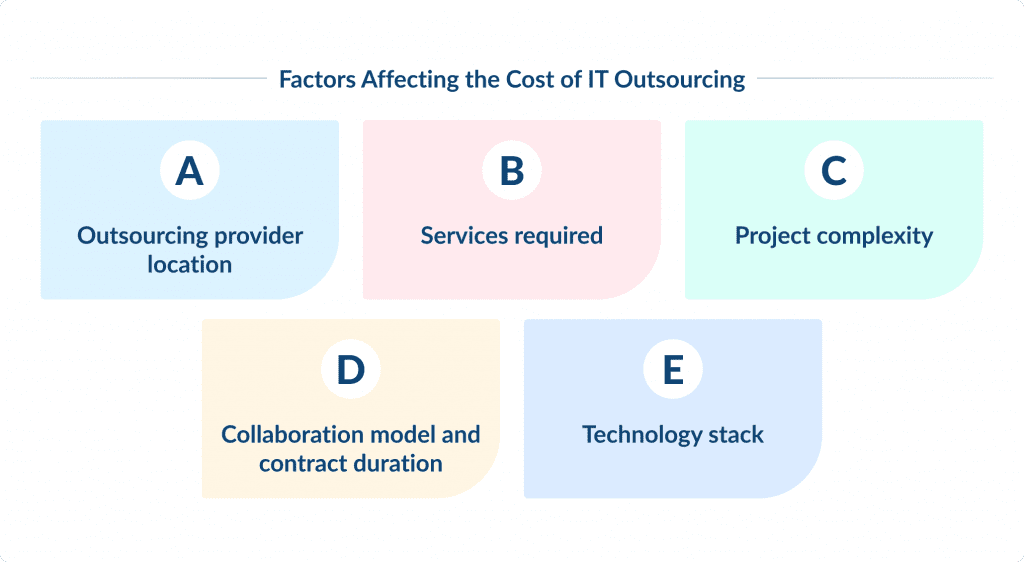IT Outsourcing Costs in 2025
- Updated: Aug 27, 2024
- 9 min
Why do companies outsource? The reasons may vary, but one of the main reasons our clients point out is that outsourcing makes finding specialists with the needed skills much easier.
Considering that 50% of executives find talent acquisition to be the top internal challenge for their organizations, outsourcing is a reasonable solution.
However, there is another important aspect when it comes to IT outsourcing. We are talking about budget optimization. So, is it really cheaper to outsource than hire in-house? Let’s talk money matters.
Transform your ideas into reality with top-tier software developers — contact us to get started!
Average Cost to Outsource IT in 2025
The global revenue in the IT outsourcing market is projected to reach $512.50 billion in 2025. It is expected to grow with an annual growth rate of 10.99%, resulting in a market volume of $777.70 billion by 2028.
Statista points out that the average spend per employee in the IT outsourcing market is estimated at $146.10. However, the exact price will depend on multiple aspects, such as the team’s location, project complexity, and other factors that we will examine later.
You can enhance your company’s overall operational efficiency when delegating your app development project to specialists (see how to start an app). According to OnContracting, businesses can save an average of $100,000 annually by outsourcing app development.
To better understand the costs of IT outsourcing, we must first explore the most popular pricing models on the market. These are co-managed IT, managed IT, and Break-fix IT.
IT Outsourcing Pricing Models
These are the three main pricing models in IT. Let’s explore each one and its pricing structure.
-
Co-managed IT
In this model, the organization collaborates with an external IT service provider to manage specific aspects of its infrastructure. It’s a hybrid approach where both parties share responsibilities.
Use Case
Co-managed IT suits businesses with an in-house IT team but requires additional expertise or support for specific projects or tasks.
In this way, organizations can tap into specialized expertise without completely outsourcing all IT functions.
Making the right choice is crucial. Here’s everything you need to know about in-house development vs. outsourcing.
Pricing Structure
Typically, co-managed IT services are billed based on a combination of fixed fees (for specific services) and hourly rates (for ad-hoc support).
-
Managed IT
The entire IT infrastructure is outsourced to a third-party provider. The external vendor manages and maintains the organization’s IT systems.
Use Case
Managed IT is ideal for businesses focusing on core operations while delegating IT management entirely to experts.
It provides proactive monitoring, maintenance, and support.
Pricing Structure
Managed IT services are usually provided through a subscription model. The cost is determined by factors like the range of services, the number of devices, and the level of support needed.
-
Break-fix IT
Organizations that use the break-fix model only engage in IT services when issues arise. The external provider handles problems reactively, as they arise.
Break-fix is a great choice of IT outsourcing for small business with limited budgets or irregular IT needs.
It’s often used for one-time projects or occasional troubleshooting.
Companies usually bill break-fix services per incident or for the time spent fixing issues.
Since IT break-fix costs vary by problem, the bill is hard to predict.
For fixing minor issues, specialists can change from $20 to $50 per hour.
Additional expenses like hardware replacement, software licenses, and extended technical support are not usually included in this rate.
Costs increase as a problem grows larger.
| IT Outsourcing Option | Cost |
| Co-Managed IT | $90-$110/user per month |
| Managed IT | $130-$250/user per month |
| Break-Fix | $20-$50/hour + additional fees |
Each model has its advantages and drawbacks. The choice depends on your organization’s specific requirements, budget, and long-term IT strategy.
What Factors Affect the Cost of Outsourcing IT?
How much does it cost to outsource IT? Well, the cost can vary significantly based on several factors. Let’s briefly explore them.
-
Outsourcing provider location
The choice of service provider can greatly impact the cost of outsourcing IT services. Outsourcing to an agency in a country with a lower cost of living can be more beneficial than outsourcing to a company with a higher living cost.
For instance, hiring dedicated backend developers from Ukraine is typically more economical than outsourcing development to regions like the United States or Western Europe. We’ll elaborate more on that one further.
-
Services required
The cost of outsourcing IT services is also influenced by the nature and scope of the services you need.
Suppose you outsource various IT functions like software development, infrastructure management, customer support, and quality assurance. In that case, the price will likely be higher than outsourcing a specific task or a limited set of services.
-
Project complexity
Another thing to keep in mind is that the cost of your outsource mobile app development or other outsourced tasks depends mainly on its complexity.
Tasks that demand specialized skills, advanced technologies, or extensive customization will incur higher costs compared to simpler projects.
For instance, outsourcing a straightforward task like mobile app design is usually less costly than outsourcing a more intricate task such as software development. Learn more about how much does it cost to design an app.
Budgeting for an app? Our article on app development costs gives you the insights you need to plan your project smartly.
-
Collaboration model and contract duration
The contract duration can impact the cost as well.
Contracts that last for a longer time often offer lower prices or other money-saving benefits. On the other hand, short-term or project-based agreements might have higher hourly or fixed rates.
This is because outsourcing providers may charge a premium for short-term engagements. They may need to ramp up quickly and cannot count on repeat business. That could affect their pricing structure.
-
Technology stack
The choice of technologies impacts costs.
Some technologies, for example, AI and ML, may require specialized expertise, affecting hourly rates. So, make sure you consider the technology stack required for your project when estimating expenses. 
IT Outsourcing Costs by Region
If you’re interested in hiring developers in the UK, Canada, Australia, or anywhere else, the cost of IT outsourcing will vary depending on the country you choose.
That is because professionals in some regions expect a higher hourly rate than others. Often, several key factors influence their expectations. The cost of living in their part of the world is the most significant one.
Looking at how much it costs to outsource IT work in different parts of the world helps you see where you can get good value for your money.
This means small businesses and startups can spend less on their IT needs while still getting really good skills.
Below is an overview of the typical hourly rate range in multiple regions. The rates are based on the 2023 Accelerance Global Software Outsourcing Trends and Rates Guide:
- North America: $62 to $209 per hour
- Latin America: $34 to $96 per hour
- Central and Eastern Europe: $26 to $95 per hour
- Southeast Asia: $18 to $70 per hour
- South Asia: $24 to $71 per hour

The data shows that Eastern Europe is one of the most popular destinations for companies looking to outsource their IT activities. Let’s see why.
IT outsourcing in Eastern Europe
The IT outsourcing industry in Central and Eastern Europe is doing really well. It’s growing much faster than the rest of the world. About 4-5 times faster. While globally, it’s only increasing by about 5% each year, here, it’s jumping by 20-25% annually.
According to Clutch, 3,526 companies in Eastern Europe sell IT outsourcing services. 988 of them are based in Ukraine, 1345 in Poland, 453 in Romania, and 133 in the Czech Republic.
IT specialists from these countries are well-educated and knowledgeable, and they speak English fluently, according to the English proficiency index data.
The costs of IT outsourcing services in Eastern Europe vary by country. For instance, hiring developers in Ukraine tends to be less costly compared to Romania or the Czech Republic. It is also much cheaper than in Poland since this country has the highest rates in the region.
On average, you might pay around $30 for a junior software developer and $50 or more for a senior software engineer from Eastern Europe.
| Position | Average Rates (per Hour): |
| Junior Developer | from $20 – $30. |
| Mid-Level Developer | from $30 – $50. |
| Senior Developer | from $50 – $80. |
Besides reasonable pricing and knowledgeable specialists, there are a few more advantages of hiring IT specialists from Ukraine.
These are some of them, based on the feedback from our clients:
- Ukrainian teams often share cultural similarities with Western clients.
- Most IT professionals have solid language skills.
- Ukraine hosts a vibrant tech community with expertise in various domains.
- The time zone aligns well with European working hours.
In summary, Eastern Europe, particularly Ukraine, is a great option for IT outsourcing.
It combines skilled talent, competitive rates, and a cultural fit.
We are your reliable white-label companion for design and development services.
Hidden Costs of Outsourced IT Services
When it comes to IT outsourcing, there might be some hidden costs you need to be aware of. Here are some of the expenses companies may consider as unpredictable.
Currency fluctuations
Currency fluctuations can significantly impact costs.
For example, an invoice of $1 million a month could become $1.4 million due to currency changes. To mitigate this risk, consider including caps and collars in the contract.
Misaligned business needs
Sometimes, companies don’t clearly know what they want when they decide to hire outside help for their IT needs. This lack of clarity can make things less efficient.
It’s important for businesses to make sure that their goals match up with their plans to hire outside help for IT tasks. This way, they can avoid spending more money than they expected. This is all about making sure everyone is on the same page to get the best results without any surprises.
Refactoring and upgrading
As technology evolves, there may be a need for system refactoring or upgrading.
These activities can incur additional costs that weren’t initially anticipated.
Scaling team and role changes
As project requirements evolve, you might need to scale up or down your team.
Adjusting team sizes or roles can impact costs. However, it depends on the vendor you work with. For example, at SpdLoad, we won’t charge you if you decide to change a specialist on the project.
Implementing new features and changes
Adding new features and services or making changes during the outsourcing engagement can lead to unforeseen costs.
Ensure that any modifications are well-documented and understood.
Summing up, while there are multiple IT outsourcing benefits, it’s crucial to be aware of these hidden costs we’ve highlighted. Diligence in contract negotiation, clear communication, and proactive management can help mitigate surprises and ensure a successful collaboration.
Why IT Outsourcing is Still the Best Option in 2025
Hiring external companies or professionals to handle your IT needs is still a great choice this year. And not just because of IT outsourcing cost savings.
Here are a few more reasons why:
- Access to specialized skills
The technology landscape evolves rapidly. Outsourcing provides access to experts skilled in the latest tools, languages, and frameworks.
Whether it’s AI, blockchain, or cybersecurity, outsourcing ensures you work with professionals who stay ahead of the curve.
- Scalability and flexibility
Outsourcing allows businesses to scale up or down quickly based on project needs.
Seasonal demands, product launches, or sudden growth can be accommodated without long-term commitments.
- Global talent pool
Geographic boundaries are irrelevant when it comes to outsourcing. You can collaborate with top talent worldwide.
Diverse perspectives and cultural insights enhance creativity and problem-solving.
- Focus on core competencies
By outsourcing non-core functions, organizations can concentrate on their unique value proposition. Strategic focus leads to innovation and competitive advantage.
- Risk mitigation
Outsourcing diversifies risk. If one team faces challenges, others can step in.
Disaster recovery, security, and compliance are often better managed by specialized providers.
- Reduced time to market
Outsourcing accelerates development cycles. Faster time to market means staying ahead of competitors.
- Innovation and creativity
Exposure to diverse ideas fosters innovation. Outsourced teams bring fresh perspectives and creative solutions.
- Strategic partnerships
Outsourcing isn’t just transactional; it’s about building long-term partnerships. Collaborate with providers who align with your vision and goals.
Looking to collaborate effectively? Our guide on app development partnerships explains what to consider.
Why Outsource IT Services to Spdload?
At the end of the day, you want to get the full value of the price you pay for IT services. While outsourcing IT costs are important, it shouldn’t be the only thing you think about when deciding to outsource.
Quality, reliability, security, and meeting your business needs are just as important. So, it’s essential to consider all these factors, not just the cost.
As a third-party IT provider, we’ve got everything you need for a successful and hassle-free collaboration:
- Dedicated teams
- Outstaff developers
- Product development from scratch
- Discovery phase
- UX/UI design
Whether you need to build a website from scratch or develop an MVP for your ed tech startup that will help you raise your first investment – we’ve got you covered.
You’ll find that our recruitment process is twice as fast as internal hiring. Having a reliable outsourcing team on your side allows you to dedicate time to your core activities.
If you have more questions, book a meeting with our dedicated development team today for quick answers that will help guide your decisions.













